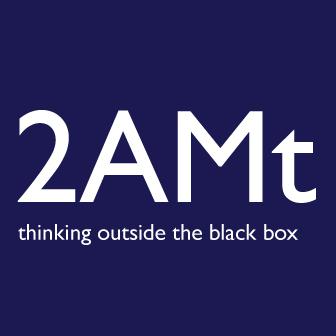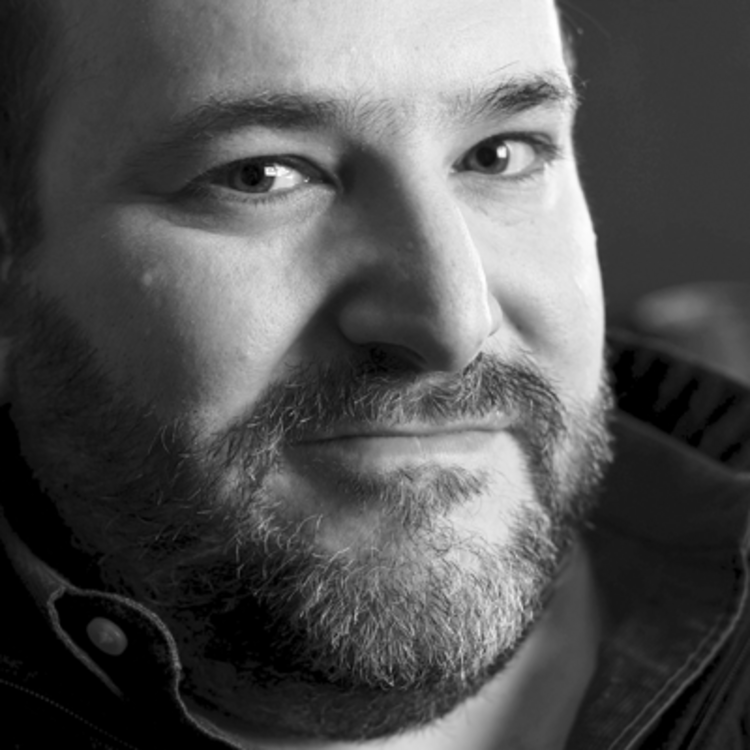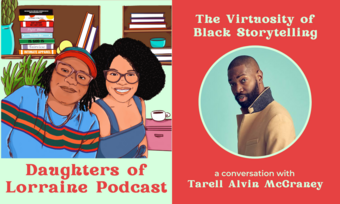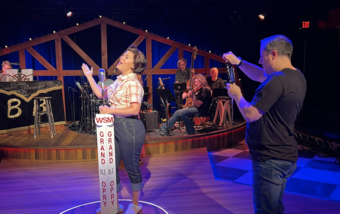Theater, Twitter, and Revolution
When you think about the connection between Twitter and theatre, what’s the first thing that comes to your mind? For many of us, it’s the sight of a little rectangle of telephone light blinking into focus a few rows in front of you in a darkened theatre—right in the middle of a performance—so that some annoying patron can Tweet about the show… or about which bar to visit when the show’s over. In truth, however, all the hand-wringing about tweeting in the theatre is really nothing more than a distraction from the far more important, positive, and legitimate ways in which Twitter is changing our art form. Perhaps because Twitter is barely five years old, it’s still rather easy to dismiss the technology as a passing fancy. In the digital era in which we live, however, five years is forever; there are 200 million people using the service now, which makes that half-decade stunningly successful.
Malcolm Gladwell may believe the revolution will not be tweeted, but (with all due respect to a man I otherwise admire who I think missed the mark on that front) Twitter itself seems to be the revolution. But what kind of revolution does Twitter represent, exactly? The nature of the application—its core promise—has proven difficult to pin down, though many commentators have suggested (and I tend to agree) that what Twitter does is help ideas spread more quickly, more transparently, and across more social strata than ever before. This is as true for theatrical ideas as it is for any other. According to noted arts and social media expert Devon Smith, Twitter has allowed “the kind of conversations that used to take place primarily at conferences and your local bar” to happen instead “year-round, in a very public way, within what's likely a more diverse (by way of size, geography, and artistic discipline) community.”
If you’re reading this article, for example, there’s a very good chance you discovered it via a link somebody shared on Twitter. Not long ago, you might only have stumbled across an article on theatrical innovation in a Google search, or an acquaintance might have emailed it to you. Before the internet, your only options to find articles on what’s new and up and coming in the theatre were journals and newspapers, very few of which shared Twitter’s international, cross-cultural reach. Ideas about theatrical innovation had to have mighty stamina to survive in that environment.
All the hand-wringing about tweeting in the theatre is really nothing more than a distraction from the far more important, positive, and legitimate ways in which Twitter is changing our art form.
In the pre-Twitter world, the social status of the person sharing a new idea went a long way to ensure that it survived and replicated. The artistic director of a major theatre company getting behind an innovation almost certainly legitimized it. The speed with which ideas spread via Twitter, however, means that they can begin to earn interest and traction and intellectual investment before they get a seal of approval (or the sneer of disapproval) from anyone “important.” The marketplace has become part mad dash, part anonymous suggestion box; ideas more often live or die on their own merit. Case in point: 2am Theatre.

Just over a year ago, a small group of theatre practitioners from all around the country were exchanging tweets at around 2 am—thus the name—about the state of theatre. Out of their rapid-fire, late-night conversation (which you can read here) came the #2amt hashtag, which hundreds (or is it thousands now?) of theatre practitioners append to their tweets when they want to contribute to the ongoing conversation. The hashtag quickly grew into a blog that serves as a hub for more in-depth high-profile discussion about theatre. 2am Theatre produces theatre podcasts, hosts live-streamed plays, and does a good bit of rabble-rousing on behalf of the national and international theatre community to boot. All in only one year.
“Without Twitter,” said founder David J. Loehr, “the initial late night conversation that sparked 2amt would never have happened.” 2am Theatre is only one representation of the second-most important element of Twitter: community. Howard Sherman, the Executive Director of the American Theatre Wing, notes the capacity of Twitter “to build common communities over vast distances. Instead of the one-to-one relationship of ‘pen pals,’ or the broader application of ‘reply all’ in e-mail, Twitter enables people to find those with common interests and communicate directly… creating an ongoing exchange with complete strangers that can foster new ideas.” For the record, and to prove his point: a year ago I didn’t know Howard at all; now we exchange ideas and banter (via Twitter) once a week or so. I feel secure in saying that before this technology existed, I’d have been lucky to meet Howard and perhaps share a few words with him—probably at some random opening night cast party—once in my life. “I have to credit [Twitter] with expanding my field of acquaintances nationally and internationally,” Sherman wrote to me, “leading to a broader range of conversation and… new face to face relationships with people who I would otherwise not know.”
Speaking as a playwright, I can also attest to the ability of Twitter to break through the somewhat notorious playwright/artistic director barrier. Active participation in Twitter has led to a great many opportunities for me, from the production of one play to the reading of another to several devised work projects. I’m not unique in this: a quick query on (of course) Twitter yielded not only other playwrights, but also a few directors (and even one dramaturg) with similar stories. If Twitter can do what the last few decades of American theatre have failed to achieve—bring playwrights and artistic directors into greater harmony—there may be nothing it cannot accomplish. When it comes to marketing, furthermore, Twitter has quickly become an essential tool in every theatre’s tool belt… though far too few of them seem to know quite how to use it. “While I see many theatrical organizations using Twitter for their marketing,” said Sherman, “in most cases I find use of the application to be obvious and old-school; most use Twitter as nothing more than an adjunct to their e-mail blasts and old-line marketing techniques.”
The promise of Twitter seems to be engagement: a two-way dialogue between a theatre and its audiences. If all a theatre does is re-tweet links to positive reviews, make season announcements, and promote the fact that tickets for such-and-such performance are selling quickly, employing Twitter for one-way communication, that theatre will do more harm to its brand than good. Alli Houseworth, marketing and communications director of Woolly Mammoth Theatre Company, understands that Twitter is best used to connect audiences to the stories being told on stage: “So much of the social media work I do at Woolly is all about transparency. How can I open up the proverbial doors of how we create work to our online audiences? My theory is that the more my audience feels invested in the process of creating new work, the more they will value the experience of attending it live… I want our process to no longer be mysterious, elitist, or something that’s created in a far off room with closed doors.” For Alli, Twitter helps theatres “democratize the theatre-making process.”
In some cases, Twitter has also helped theatre practitioners completely re-invent the theatre-making process… or even redefine what theatre actually is. Too many theatres to enumerate have asked artistic staff to “live-tweet” a show (usually from the safety of the booth) as a way of creating a kind of “director’s commentary” on the performance, but countless experiments have been far more adventurous than that. A few of the more well-known or interesting:
- The Royal Shakespeare Company adapted Romeo and Juliet into a six-character story called Such Tweet Sorrow that was “performed” entirely in 140-character tweets over a five-week period.
- The Playground Theatre uses audience member tweets to improvise new shows.
- The New York Neo-Futurists regularly ask their Twitter followers to write one-tweet plays with specific constraints—beyond, of course, the constraint of using no more than 140 characters—and then share the results with their followers the next day.
- The playwright Chinaka Hodge used Twitter to “write into being,” in a digitally public way, the characters in her play Mirrors in Every Corner.
- A project called Reorbit has invited writer/actors to inhabit historical or fictional characters in real-time on Twitter, creating “plays”—traditional terminology begins to fail here—that involve audience interaction.
For all the experimentation and innovation Twitter seems to have inspired among theatre practitioners, however, there seem to be some indications that not everyone is embracing this new technology. Perhaps somewhat predictably, those who hold positions of theatrical authority and leadership may be resisting the new levels of transparency and grass-roots energy Twitter is injecting into the arts. As Scott Walters, director of the Center for Rural Arts Development and Leadership Education, wrote about a meeting he attended at the NEA, “[T]he way that bloggers and tweeters were talked about by the assembled leaders… wasn't good.” In Walters’ opinion, “These leaders are used to controlling the conversation from their privileged positions. If they think it ought to be talked about, it will be; if not, it will be silenced.”
Twitter, however, isn’t going away. To paraphrase Clay Shirky, a writer on internet techologies, here comes everybody… whether the nation’s theatre leaders are ready or not. “I think we’re still in the early days of social media,” said Howard Sherman. “Only time will tell whether the industry’s stratification can truly be broken down by Twitter or any other application. But, as the saying goes, wouldn’t it be nice to think so?” Yes, Howard, it really would. And if you don’t agree, I suggest you join Twitter (if you haven’t already), click any of the names I’ve hyperlinked in this article, and start following all the people I’ve suggested. (Feel free to follow me, too.) I sincerely believe that in no time at all, you’ll be convinced.















Comments
The article is just the start of the conversation—we want to know what you think about this subject, too! HowlRound is a space for knowledge-sharing, and we welcome spirited, thoughtful, and on-topic dialogue. Find our full comments policy here
Country? World. People from everywhere were chiming in that night: UK, Australia, Canada, South America...still boggles my mind...
I was so baffled by twitter, that Michael Dove, Artistic Director of Forum Theatre, sent me this article by Gwydion Suilebhan, which has clarified things enormously. There is still much for me to learn, but at the least, I now see twitter as an important tool for communication, creativity, and social media. Thanks for the clarity, Gwydion.
Thanks, Annie! Good to hear from you.
Love this post.
I signed up for twitter probably a year before I became active and I have learned so much from the 2amt posts and conversations. As an independent theatre producer I often feel that the local conversations in which I am involved are more about complaining ( usually about ' lack of'-audience, money, space, resources-blah blah blah) rather than finding solutions and just making the art happen-which, quite frankly as a producting actor, is why I started producing in the first place. I am inspired by the art and passion with which you are all working and have appreciated the info share that I can now utilize in my own projects.
Please keep it coming !
Great article. I'm a playwright new to twitter and I've been asking a lot of playwright friends how they use it and if it helps them. So far, the response is mixed but most of us are learning how to use it effectively. Plus, I can tweet to William Shatner so I'm pretty happy.
The more you give Twitter, I promise, the more it gives back!
my favorite so far is to not try and name scripts,
or cpmposed texts,
via a twitter enhanced bit of writing world or genre jargon
but rather
name the growing field of practice that lives at the intersection of literature and time-based live encounter-
"tweatre"...
There are several permutations here that I've heard:
Tweeater, which is my favorite
Twittre, which is certainly clever
I find that this attitude towards social media lives in the other worlds in which I live--the association community and foodservice distribution. Support from the top is key. What I had to push through from our executive team was the control issue that you touch on above; however, once they saw that tweeting and all other social media tools could do more good than harm, they were all for it. They're not tweeting. Yet.
Twitter is NOT going to go away, that's for sure. So I guess the next step is to figure out a name for the tweeted plays that are being created: "Twamas?" "Twomadies?"
Yeah, I got nothin'...
:)
LOL @ Twamas.
Nice article. I signed up for a Twitter account a few weeks ago (monicabyrne13) but it's remained silent, because I still don't have a clear idea of how to use it as a playwright. Now I have a few ideas :)
That's a great, thoughtful article- nicely done.
I look forward to sharing it.
and re-visiting my pretty quiet twitter account...
HOORAY, Gwydion, and THANK YOU for explaining the Twitter Revolution in such an accessible fashion. Being IN IT I experience the excitement, and now thanks to you, I have a new perspective too. See you at @2amt!